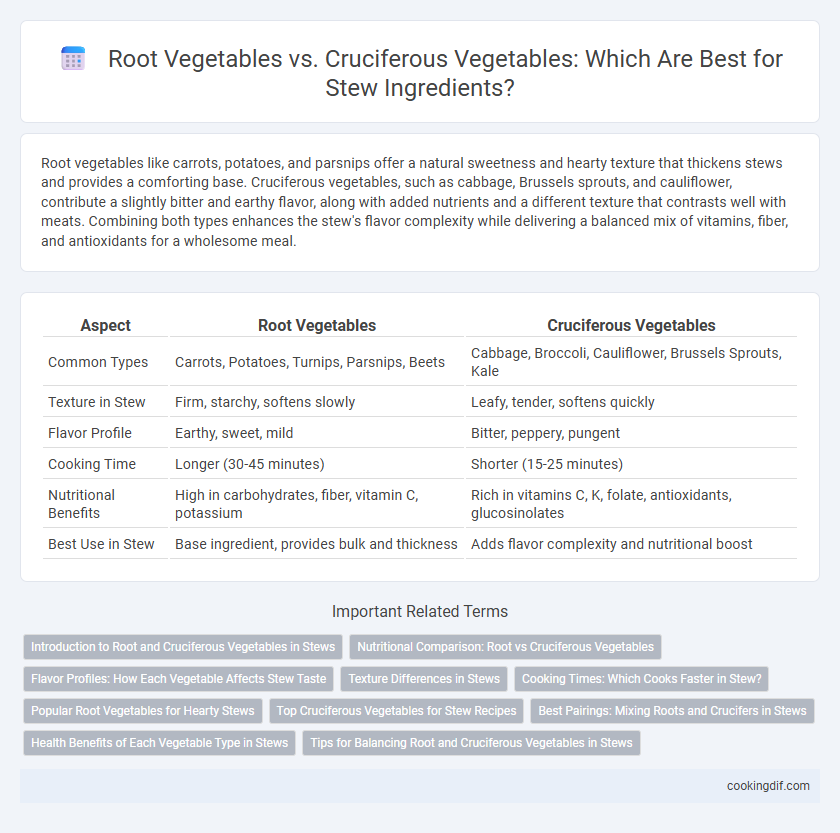Root vegetables like carrots, potatoes, and parsnips offer a natural sweetness and hearty texture that thickens stews and provides a comforting base. Cruciferous vegetables, such as cabbage, Brussels sprouts, and cauliflower, contribute a slightly bitter and earthy flavor, along with added nutrients and a different texture that contrasts well with meats. Combining both types enhances the stew's flavor complexity while delivering a balanced mix of vitamins, fiber, and antioxidants for a wholesome meal.
Table of Comparison
| Aspect | Root Vegetables | Cruciferous Vegetables |
|---|---|---|
| Common Types | Carrots, Potatoes, Turnips, Parsnips, Beets | Cabbage, Broccoli, Cauliflower, Brussels Sprouts, Kale |
| Texture in Stew | Firm, starchy, softens slowly | Leafy, tender, softens quickly |
| Flavor Profile | Earthy, sweet, mild | Bitter, peppery, pungent |
| Cooking Time | Longer (30-45 minutes) | Shorter (15-25 minutes) |
| Nutritional Benefits | High in carbohydrates, fiber, vitamin C, potassium | Rich in vitamins C, K, folate, antioxidants, glucosinolates |
| Best Use in Stew | Base ingredient, provides bulk and thickness | Adds flavor complexity and nutritional boost |
Introduction to Root and Cruciferous Vegetables in Stews
Root vegetables such as carrots, parsnips, and turnips offer a natural sweetness and dense texture that enrich stews with hearty flavors and thick consistency. Cruciferous vegetables like cabbage, Brussels sprouts, and broccoli provide a slightly bitter, earthy taste and contribute essential nutrients like vitamins C and K, enhancing both flavor complexity and health benefits. Combining these vegetables creates a balanced stew, leveraging the sweetness of roots and the robust profile of crucifers for a well-rounded, nutritious dish.
Nutritional Comparison: Root vs Cruciferous Vegetables
Root vegetables like carrots, potatoes, and parsnips provide a rich source of complex carbohydrates, fiber, and essential vitamins such as vitamin A and potassium, making them excellent for energy and digestion in stews. Cruciferous vegetables, including broccoli, cauliflower, and Brussels sprouts, are high in antioxidants, vitamin C, and glucosinolates, which support immune function and reduce inflammation. Incorporating both root and cruciferous vegetables into stews balances nutrient density by combining sustained energy from carbohydrates with the disease-fighting properties of phytochemicals.
Flavor Profiles: How Each Vegetable Affects Stew Taste
Root vegetables like carrots, parsnips, and turnips offer a natural sweetness and earthiness that deepen the stew's flavor and create a hearty base. Cruciferous vegetables such as cabbage, Brussels sprouts, and kale contribute a slightly bitter, peppery, and sometimes pungent note that adds complexity and balance. Combining both types enhances the stew with layers of savory, sweet, and tangy flavors, resulting in a rich and well-rounded taste profile.
Texture Differences in Stews
Root vegetables like carrots, potatoes, and parsnips offer a dense, hearty texture that thickens stews and retains firmness after long cooking. Cruciferous vegetables such as cabbage, Brussels sprouts, and cauliflower provide a softer, more fibrous texture that breaks down quicker, adding a delicate body to the broth. Combining both types enhances stew complexity by balancing firm chunks with tender, melt-in-the-mouth elements.
Cooking Times: Which Cooks Faster in Stew?
Root vegetables like carrots, potatoes, and parsnips generally require longer cooking times in stews, often needing 30 to 45 minutes to become tender due to their dense texture. Cruciferous vegetables such as broccoli, cauliflower, and Brussels sprouts cook faster, usually softening within 10 to 15 minutes without becoming overly mushy. For optimized stew preparation, adding cruciferous vegetables in the last 10 minutes preserves texture while inserting root vegetables earlier ensures even cooking.
Popular Root Vegetables for Hearty Stews
Popular root vegetables for hearty stews include carrots, parsnips, and potatoes, prized for their dense texture and natural sweetness that intensifies with slow cooking. These vegetables provide a robust, earthy flavor and absorb broth well, creating a thick, satisfying base. Cruciferous vegetables, such as cabbage or Brussels sprouts, tend to soften quickly and add a slightly bitter contrast, making root vegetables a preferred choice for long-simmered stews.
Top Cruciferous Vegetables for Stew Recipes
Top cruciferous vegetables for stew recipes include cabbage, Brussels sprouts, and cauliflower, which add a robust texture and rich flavor profile. These vegetables are high in fiber, vitamins C and K, and antioxidants, enhancing both the nutritional value and taste complexity of the stew. Their slight bitterness and earthiness complement the heartiness of root vegetables such as carrots and parsnips, creating a balanced and nutrient-dense dish.
Best Pairings: Mixing Roots and Crucifers in Stews
Root vegetables like carrots, parsnips, and potatoes add natural sweetness and hearty texture to stews, while cruciferous vegetables such as cauliflower, Brussels sprouts, and cabbage bring a slightly bitter, earthy flavor that balances richness. Combining these two vegetable groups enhances both taste complexity and nutritional value, as roots provide dense carbohydrates and crucifers offer antioxidants and vitamins C and K. The best pairings include pairing sweet parsnips with robust Brussels sprouts or creamy potatoes with mild cauliflower to create a harmonious blend of flavors ideal for slow-cooked stews.
Health Benefits of Each Vegetable Type in Stews
Root vegetables such as carrots, parsnips, and turnips provide essential vitamins like vitamin A, potassium, and fiber that support digestion and immune health when included in stews. Cruciferous vegetables, including broccoli, cauliflower, and Brussels sprouts, offer high levels of antioxidants, vitamin C, and glucosinolates that promote detoxification and reduce inflammation. Combining both vegetable types in stews enhances nutrient diversity, supporting cardiovascular health and cellular repair.
Tips for Balancing Root and Cruciferous Vegetables in Stews
Balance root vegetables like carrots, potatoes, and parsnips with cruciferous vegetables such as cabbage, broccoli, and Brussels sprouts to achieve a harmonious stew texture and flavor. Roasting root vegetables before adding them preserves sweetness, while lightly steaming cruciferous vegetables prevents bitterness and maintains their nutritional profile. Incorporate sturdy roots early for even cooking and add cruciferous greens in the last 10-15 minutes to avoid overcooking and retain vibrant color.
Root vegetables vs cruciferous vegetables for stew ingredients Infographic

 cookingdif.com
cookingdif.com